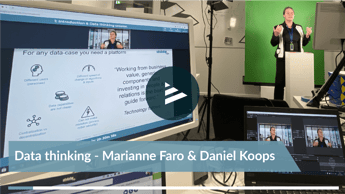I used an example about the Dahlia of my mother in law that did not flourish. I showed her that with the use of data science she could better take care of the plant. By daily measuring of the temperature in the garden, the amount of sunlight, the humidity of the soil, and to combine those values with the color of the leaves and flowers. She immediately was enthusiastic! Especially after I explained that based on that data, I would be able to predict if her Dahlia's needed more water or needed to be replanted. Or that she might need to consider a new fertilizer.
Next a good summary of JT Kostman:
"Data Science, when all's said and done, is about extracting meaning from unimaginable amounts of information; what the press calls "Big Data". It's about finding a subset of needles in a haystack made out of needles.
Imagine listening to the chaotic cacophony of Twitter - 500 million tweets per day - and being able to distill it in a way that lets you understand exactly what's on everyone's mind. Or culling through the 200+ items purchased every second on Amazon to predict what a particular person might want before they even know they want it. Or better still, what someone they've never met might also like. What if you could look at the millions of baskets that come through Target to tell you that the one with binkies and baby food will also want wipes - but more impressively, what if you could look back to be able to tell that the soon-to-be mom was expecting before she even bought the EPT...
Data Science, in short, is about finding patterns that allow us to understand, predict, and even influence what comes next. It's about using computers, data, and math to make sense of an increasingly complicated and complex world."
Some other examples:
#1: Cooking:
"My mother-in-law likes to cook for us. She really can’t take it if we don’t enjoy her food once in a while. Maybe I could show her how data science works. We could evaluate her food every time, and I would analyze the ingredients of the recipe straight away. Then in a couple of months, she would see that we prefer Italian dishes to French ones. She would even be able to predict our reaction if she served up certain ingredients."– By Sam van Beuningen
#2: Automated driving
"I was recently asked how those self-driving cars worked and whether they could be safe without human interaction. Following an extensive discussion about how we learn things like object recognition, location determination and movement prediction, it boiled down to the fact that the car also must learn these things. And because we equip it with the right tools and algorithms, it is able to do so. Then I thought to myself that this is a great analogy for the work of Data Scientist. So nowadays I don’t just do something with computers, but also something with smart cars. In other words, another step in the right direction." – By Maarten Hofmeester
#3: Online shopping
"The example that works well for me is the recommendations made in web shops. If my mother-in-law orders a new pair of shoes, a matching outfit is recommended as if by magic. But how’s that possible? It’s not as if a team of stylists is working day in day out on creating fabulous new combinations. The recommendations are made purely based on what other people bought who ordered the same pair of shoes. This can be combined with a user profile that’s compiled based on which products you view or order. The user profile also means that advertisements can be better targeted and offers are more relevant. The longer you spend in a web shop, the better the system gets to know you.” – By Sander den Heijer
#4: TV on demand
"My parents-in-law have recently started watching Netflix and the suggestions about which series they might enjoy keep getting better. Two types of data are used for this. On the one hand, you can indicate yourself whether you enjoyed a particular series by giving a thumbs-up. On the other hand, there’s a certain viewing behavior, as watch data is collected from millions of Netflix viewers. This data contains what people are watching now, have watched before and after a specific movie. Together with what they watched a year ago and on which time they did all that, this data is linked to tags that Netflix staff give to an episode or series.
Eventually, a machine learning model determines how important each bit of data is and viewers’ groups are formed. As a viewer, you too are placed in a viewers’ group and will be given certain suggestions based on this group. If your tastes change over time and your behavior becomes different from the viewers’ group, then in due course you’ll be moved into another group and the algorithm will adjust the suggestions.” – By Stan van Velthoven
#5: Watching soaps
Your mother in law is most likely to watch "Goede Tijden Slechte Tijden" a daily Dutch soap series. Everybody knows that series (in the Netherlands). So, what did I do, I applied text mining to the 5000 daily summaries of the soap. People can relate the results of text mining to the series. This makes it easier to bring over some data science concepts.” – By Longhow Lam
 Back to overview
Back to overview





